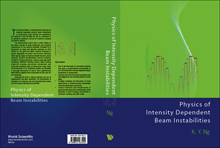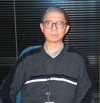 | Monday, January 23, 2006 |
|
Monday, January 23
Tuesday, January 24 |
|
|
Secon Level 3 |
|
Monday, January 23 - Potato Au Gratin - Monte Cristo - Savory Roasted Chicken Quarters - Lasagna Bolognaise - Chicken Ranch Wrapper - Assorted Pizza Slices - Szechuan Style Pork Lo Mein The Wilson Hall Cafe accepts Visa, Master Card, Discover and American Express. |
|
Wednesday, January 25
Thursday, January 26
Chez Leon Menu |
| Fermilab Today is online at: http://www.fnal.gov/today/ Send comments and suggestions to today@fnal.gov Fermilab Today archive Hurricane Relief Page Fermilab Today PDF Version Fermilab Result of the Week archive Fermilab Safety Tip of the Week archive Linear Collider News archive Fermilab Today classifieds Subscribe/Unsubscribe to |
| New Book by K.Y. Ng For Researchers, Grads |
||
| ||
| Thousands of physicists would prefer smaller and more intense beams. But how small and how intense can you go before the beam becomes unstable? Instabilities inherently set the limit of beam intensity and particle bunch sizes, and impinge on many aspects of an accelerator's overall design.
Physicist K.Y. "Bill" Ng's book, Physics of Intensity Dependent Beam Instabilities, which was recently published by World Scientific Publishing Co., addresses such issues. Ng, a Fermilab employee for over 25 years, decided to write the book after teaching in the U.S. Particle Accelerator School for several years. "I gave lectures on beam instabilities," said Ng. "The book expands on what I taught in the lectures."
Ng's book covers the most common density dependent beam instability problems for accelerators and discusses different solutions. He also
Physics of Intensity Dependent Beam Instabilities is geared toward both researchers and graduate students in accelerator physics. More details on the book can be found at the publisher's Website.
|
|
From PPARC Press Release, January 18, 2006: World's Largest Telescope European funding has now been agreed to start designing the world's largest telescope. The "Square Kilometre Array" (SKA) will be an international radio telescope with a collecting area of one million square metres - equivalent to about 200 football pitches - making SKA 200 times bigger than the University of Manchester's Lovell Telescope at Jodrell Bank and so the largest radio telescope ever constructed. Such a telescope would be so sensitive that it could detect TV Broadcasts coming from the nearest stars. The four-year Square Kilometre Array Design Study (SKADS) will bring together European and international astronomers to formulate and agree the most effective design. The final design will enable the SKA to probe the cosmos in unprecedented detail, answering fundamental questions about the Universe, such as "what is dark energy?" and "how did the structure we see in galaxies today actually form?".
The new telescope will test Einstein's General Theory of Relativity to the limit - and perhaps prove it wrong. It is certain to add to the long list of fundamental discoveries already made by radio astronomers including quasars, pulsars and the radiation left over from the Big Bang. By the end of this decade the design will be complete and astronomers anticipate building SKA in stages, leading to completion and full operation in 2020.
|
| Hierarchy of Controls | ||
Substitution - Can the work be done without the hazard being present? Can a less hazardous component be used? Obviously, eliminating the hazard is best. Isolation - Can the hazard be physically isolated so the target cannot be harmed? Physical barriers are a good solution. However, barriers can be damaged or removed. Procedures - Is there a way to do the job such that the hazard and target will not meet? Procedures are OK, but are heavily reliant on behavior. Protective equipment - Can the target be provided with a barrier or warning device so that harm can be avoided? Protective equipment is generally viewed as the weakest alternative because its effectiveness depends on equipment functioning as well as reliable behavior. The establishment of ES&H controls is just one mechanism to ensure the safety of Fermilab workers. Pre-job hazard analysis and planning is vital to the establishment of adequate controls, as is worker training and briefing. |
|
January 18 - 20 - Tevatron still down for vacuum repairs. Read the Current Accelerator Update |
|
Lederman Science Center Closed to Public The Lederman center is closed to the public today due to a water shutdown that resulted from flooding.
Summer Housing Requests
Pheasant Run Outing |


